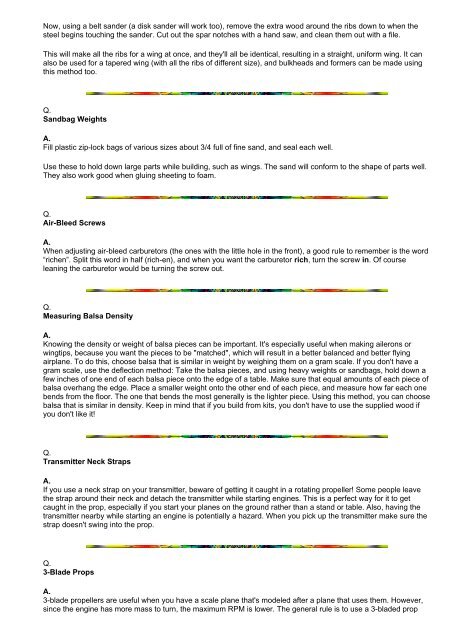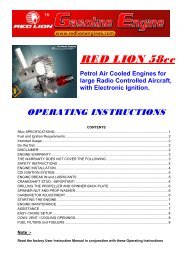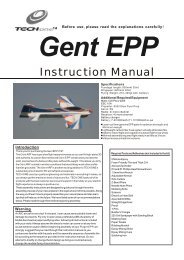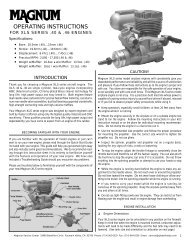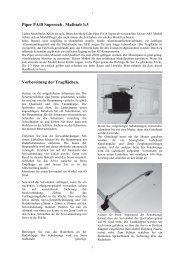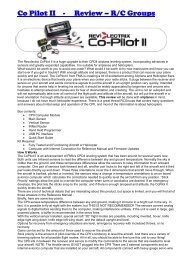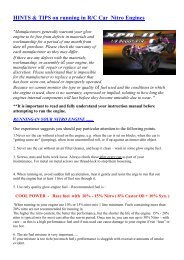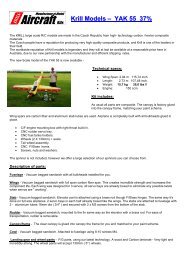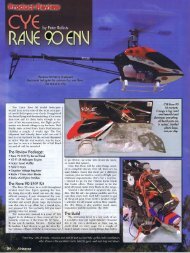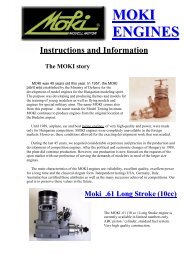Create successful ePaper yourself
Turn your PDF publications into a flip-book with our unique Google optimized e-Paper software.
Now, using a belt sander (a disk sander will work too), remove the extra wood around the ribs down to when thesteel begins touching the sander. Cut out the spar notches with a hand saw, and clean them out with a file.This will make all the ribs for a wing at once, and they'll all be identical, resulting in a straight, uniform wing. It canalso be used for a tapered wing (with all the ribs <strong>of</strong> different size), and bulkheads and formers can be made usingthis method too.Q.Sandbag WeightsA.Fill plastic zip-lock bags <strong>of</strong> various sizes about 3/4 full <strong>of</strong> fine sand, and seal each well.Use these to hold down large parts while building, such as wings. The sand will conform to the shape <strong>of</strong> parts well.They also work good when gluing sheeting to foam.Q.Air-Bleed ScrewsA.When adjusting air-bleed carburetors (the ones with the little hole in the front), a good rule to remember is the word“richen”. Split this word in half (rich-en), and when you want the carburetor rich, turn the screw in. Of courseleaning the carburetor would be turning the screw out.Q.Measuring Balsa DensityA.Knowing the density or weight <strong>of</strong> balsa pieces can be important. It's especially useful when making ailerons orwingtips, because you want the pieces to be "matched", which will result in a better balanced and better flyingairplane. To do this, choose balsa that is similar in weight by weighing them on a gram scale. If you don't have agram scale, use the deflection method: Take the balsa pieces, and using heavy weights or sandbags, hold down afew inches <strong>of</strong> one end <strong>of</strong> each balsa piece onto the edge <strong>of</strong> a table. Make sure that equal amounts <strong>of</strong> each piece <strong>of</strong>balsa overhang the edge. Place a smaller weight onto the other end <strong>of</strong> each piece, and measure how far each onebends from the floor. The one that bends the most generally is the lighter piece. Using this method, you can choosebalsa that is similar in density. Keep in mind that if you build from kits, you don't have to use the supplied wood ifyou don't like it!Q.Transmitter Neck StrapsA.If you use a neck strap on your transmitter, beware <strong>of</strong> getting it caught in a rotating propeller! Some people leavethe strap around their neck and detach the transmitter while starting engines. This is a perfect way for it to getcaught in the prop, especially if you start your planes on the ground rather than a stand or table. Also, having thetransmitter nearby while starting an engine is potentially a hazard. When you pick up the transmitter make sure thestrap doesn't swing into the prop.Q.3-Blade PropsA.3-blade propellers are useful when you have a scale plane that's modeled after a plane that uses them. However,since the engine has more mass to turn, the maximum RPM is lower. The general rule is to use a 3-bladed prop


